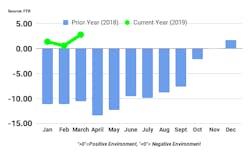FTR’s Shippers Conditions Index for March shows positive momentum
FTR’s March Shippers Conditions Index (SCI) rose two full points from February to a reading of 2.8 reflecting a continued easing of truckload and intermodal rates. The outlook is for improved shipper conditions through 2019. However, some key areas to watch are fuel price increases and capacity utilization in trucking which can result in added costs for shippers.
“Shippers are benefiting from relatively stable fuel prices and weaker trucking capacity utilization than they experienced in 2018,” Todd Tranausky, vice president of rail and intermodal at FTR, commented. “But both of those metrics are expected to tighten up as the year progresses. Diesel prices could move up in the fourth quarter ahead of the IMO 2020 fuel mandate, which could pressure fuel surcharges higher late in 2019.”
The May issue of FTR’s Shippers Update, published May 8, 2019, details the factors affecting the March Shippers Conditions Index. Also included is data and analysis on load volumes, the capacity environment, rates, costs, and the truck driver situation.
The Shippers Conditions Index tracks the changes representing four major conditions in the U.S. full-load freight market. These conditions are: freight demand, freight rates, fleet capacity, and fuel price. The individual metrics are combined into a single index that tracks the market conditions that influence the shippers’ freight transport environment. A positive score represents good, optimistic conditions. A negative score represents bad, pessimistic conditions.
The index tells you the industry’s health at a glance. In life, running a fever is an indication of a health problem. It may not tell you exactly what’s wrong, but it alerts you to look deeper. Similarly, a reading well below zero on the FTR Trucking Conditions Index warns you of a problem...and readings high above zero spell opportunity. Readings near zero are consistent with a neutral operating environment. Double digit readings (both up or down) are warning signs for significant operating changes.
About the Author
Fleet Owner Staff
Our Editorial Team
Kevin Jones, Editorial Director, Commercial Vehicle Group
Cristina Commendatore, Executive Editor
Scott Achelpohl, Managing Editor
Josh Fisher, Senior Editor
Catharine Conway, Digital Editor
Eric Van Egeren, Art Director

